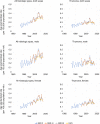Trends in the incidence of thymoma, thymic carcinoma, and thymic neuroendocrine tumor in the United States
- PMID: 31891634
- PMCID: PMC6938371
- DOI: 10.1371/journal.pone.0227197
Trends in the incidence of thymoma, thymic carcinoma, and thymic neuroendocrine tumor in the United States
Abstract
This study aimed to identify the trends in the incidence of thymic cancer, i.e., thymoma, thymic carcinoma, and thymic neuroendocrine tumor, in the United States. Data from the United States Cancer Statistics (USCS) database (2001-2015) and those from the Surveillance, Epidemiology, and End Results (SEER) database (SEER 9 [1973-2015], SEER 13 [1992-2015], and SEER 18 [2000-2015]) were used in this study. All incidences were per 100,000 population at risk. The trends in incidence were described as annual percent change (APC) using the Joinpoint regression program. Data from the USCS (2001-2015) database showed an increase in thymic cancer diagnosis with an APC of 4.89% from 2001 to 2006, which is mainly attributed to the significant increase in the incidence of thymoma and thymic carcinoma particularly in women. The incidence of thymic cancer did not increase from 2006 to 2015, which may be attributed to the increase in the diagnosis of thymic carcinoma from 2004 to 2015, with a concomitant decrease in thymoma from 2008 to 2015. Before declining, the age-specific incidence of thymic cancer peaked at ages 70-74 years, with a peak incidence at 1.06 per 100,000 population, and decreased in older age groups. The incidence of thymic cancer was higher in men than in women. Asian/Pacific Islanders had the highest incidence of thymoma, followed by black and then white people. The incidence of thymic carcinoma increased from 2004 to 2015, with a concomitant decrease in thymoma from 2008 to 2015. Asian/Pacific Islanders had the highest incidence of thymoma than other races.
Conflict of interest statement
The authors have declared that no competing interests exist.
Figures






References
-
- Travis WD, Brambilla E, Burke AP, Marx A, Nicholson AG. WHO Classification of Tumors of the Lung, Pleura, Thymus and Heart, fourth ed., International Agency for Research on Cancer (IARC), Lyon; 2015. p.184–186. - PubMed
-
- Travis WD, Brambilla E, Muller-Hermelink HK, Harris CC. Pathology and Genetics of Tumors of the Lung, Pleura, Thymus and Heart, International Agency for Research on Cancer (IARC), Lyon; 2004. p.190.
MeSH terms
LinkOut - more resources
Full Text Sources
Medical

